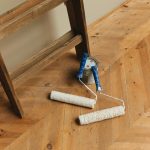Are you tired of your linen fabric looking dull and dingy? Do you want to bring life back to your favorite linen garments? Look no further! In this article, we will show you how to lighten linen fabric using natural and chemical methods.
Say goodbye to stained and discolored linen, and hello to fresh and vibrant fabric. Follow our tips and tricks to revitalize your linen and maintain its brightness.
Let’s get started!
Table of Contents
Understanding Linen Fabric
Linen fabric is known for its breathability and its ability to keep you cool in hot weather. These properties make it a popular choice for clothing, especially during the summer months. Linen is made from the fibers of the flax plant, which gives it a unique texture and feel. The fabric is lightweight and has a natural sheen, making it both comfortable and stylish to wear.
One of the benefits of using linen fabric is its durability. Linen fibers are stronger than cotton fibers, which means that linen clothing can withstand frequent washing and wear without losing its shape or color. Additionally, linen fabric is resistant to dirt and stains, making it easier to clean and maintain.
Another advantage of linen fabric is its hypoallergenic properties. Linen is naturally anti-static, which means it does not attract dust or allergens. This makes it an excellent choice for individuals with sensitive skin or allergies.
In addition to its practical benefits, linen fabric also has a timeless and elegant appearance. The natural texture and drape of linen give it a unique and luxurious look, making it suitable for both casual and formal occasions.
Overall, linen fabric offers a range of properties and benefits that make it a popular choice for clothing and home textiles. Its breathability, durability, hypoallergenic properties, and elegant appearance make it a versatile and desirable fabric option.
Preparing Linen Fabric for Lightening
When it comes to lightening linen fabric, there are a few key points to keep in mind.
First, choosing the right bleach is crucial in order to achieve the desired results without damaging the fabric.
Second, it’s important to test for colorfastness before applying any bleach to ensure that the fabric won’t fade or bleed.
Lastly, proper washing techniques should be followed to effectively lighten the linen fabric while preserving its quality and longevity.
Choosing the Right Bleach
To achieve the desired lightening effect, it’s important to choose the right bleach for your linen fabric. When it comes to lightening linen, there are a few bleach alternatives you can consider.
One option is hydrogen peroxide, which is gentler on fabrics compared to chlorine bleach. Another alternative is oxygen bleach, which is color-safe and effective in removing stains and brightening fabrics.
Whichever bleach alternative you choose, it’s crucial to follow safety precautions. Always wear gloves and protective clothing when working with bleach, and make sure to work in a well-ventilated area. Avoid mixing bleach with other cleaning products, as this can produce harmful fumes. Additionally, read the instructions on the bleach packaging carefully to ensure you are using it correctly and safely.
Test for Colorfastness
Before using any bleach or stain remover on your linens, make sure to test for colorfastness to avoid any unwanted color fading or damage. Testing the effectiveness of the bleach or stain remover on a small, inconspicuous area of the fabric will help you determine whether it is safe to use on the entire linen.
Here are some alternative methods to test for colorfastness:
- Dampen a white cloth or cotton swab with the bleach or stain remover and rub it gently on a small section of the fabric.
- Check the cloth or swab for any transfer of color from the fabric.
- If there is no color transfer, proceed to use the bleach or stain remover on the entire linen.
- If there is color transfer, consider using a different product or seeking professional help to lighten your linen fabric.
Proper Washing Techniques
Using proper washing techniques is essential to maintain the quality and longevity of your linens.
To start, choosing the right detergent is crucial. Look for a mild, non-bleaching detergent specifically formulated for delicate fabrics like linen. Harsh detergents can weaken the fibers and cause discoloration.
When it comes to washing, avoid excessive agitation. Agitating linen too vigorously can cause the fabric to lose its shape and become stretched out. Instead, opt for a gentle or delicate cycle on your washing machine.
Additionally, it’s important to avoid overcrowding the machine to allow for proper water circulation.
Lastly, always follow the care instructions on your linens to ensure you are using the appropriate temperature and drying method.
Natural Methods to Lighten Linen Fabric
If you’re looking for natural ways to lighten your linen fabric, there are two effective options. One option is to use lemon juice and sunlight. When applied to the fabric and exposed to sunlight, lemon juice can help to naturally bleach and lighten the fabric.
Another option is to use a mixture of baking soda and vinegar. This combination creates a chemical reaction that helps to lift stains and brighten the fabric.
Both methods offer natural and effective ways to lighten your linen fabric.
Lemon Juice and Sunlight
To lighten linen fabric, you can try applying lemon juice and leaving it in the sunlight. This natural method has been used for centuries and has numerous benefits. Here’s why you should give it a try:
-
Environmentally friendly: Using natural alternatives like lemon juice reduces the use of harsh chemicals, making it better for the environment.
-
Gentle on fabric: Lemon juice is a natural bleaching agent that is gentle on delicate linen fibers, preventing damage and preserving the fabric’s quality.
-
Cost-effective: Lemon juice is readily available and affordable, making it a cost-effective way to lighten linen fabric.
-
Sunlight boosts the process: Sunlight is known for its natural bleaching properties. When combined with lemon juice, it enhances the lightening effect, giving you brighter and fresher-looking linen.
Baking Soda and Vinegar
Now, let’s explore another effective method to lighten linen fabric: baking soda and vinegar. These common household ingredients offer numerous benefits for cleaning and brightening fabrics.
Baking soda, also known as sodium bicarbonate, acts as a natural deodorizer and stain remover. It helps to break down dirt and grime, leaving your linen fabric looking fresh and clean. Additionally, baking soda has a mild abrasive quality, which can gently scrub away any stubborn stains.
Vinegar, on the other hand, is a versatile cleaning agent that can be used for various purposes. When used in combination with baking soda, vinegar helps to neutralize odors and brighten the fabric. It also acts as a natural fabric softener, leaving your linen feeling soft and smooth.
Here is a table summarizing the benefits of baking soda and vinegar for lightening linen fabric:
| Baking Soda Benefits | Vinegar Uses |
|---|---|
| Natural deodorizer | Neutralizes odors |
| Stain remover | Brightens fabric |
| Mild abrasive | Softens fabric |
Chemical Methods for Lightening Linen Fabric
You can use bleach or hydrogen peroxide to lighten linen fabric. These chemical alternatives offer safe bleaching techniques that can effectively lighten your linen without causing damage.
Here are some reasons why you might consider using these methods:
-
Efficiency: Bleach and hydrogen peroxide are powerful agents that can lighten linen fabric quickly and effectively.
-
Versatility: These chemicals can be used on a wide range of linen fabrics, from clothing to curtains, ensuring you can achieve the desired lightening effect on any linen item.
-
Convenience: Bleach and hydrogen peroxide are readily available in most households, making them easily accessible for lightening linen fabric without having to purchase additional specialized products.
-
Control: By adjusting the concentration and duration of the treatment, you have control over the lightening process, allowing you to achieve the desired shade and avoid over-lightening.
When using bleach or hydrogen peroxide to lighten linen fabric, it is important to follow the instructions carefully and perform a patch test to ensure compatibility with your fabric. Always wear protective gloves and work in a well-ventilated area to minimize any potential risks.
Tips for Maintaining Lightened Linen Fabric
Now that you’ve successfully lightened your linen fabric using chemical methods, it’s important to know how to maintain its freshness and prevent discoloration. By following a few simple tips, you can ensure that your lightened linen fabric stays vibrant and beautiful for a long time.
Firstly, it’s crucial to wash your linen fabric gently and separately from other garments. Use a mild detergent and avoid harsh chemicals or bleach, as they can cause discoloration. Additionally, always wash your linen fabric in cold water to prevent any fading or color loss.
After washing, avoid wringing or twisting the fabric to remove excess water. Instead, gently squeeze out the water and then lay it flat to dry. Hanging linen fabric can cause it to stretch and lose its shape, so it’s best to avoid this.
To maintain the freshness of your lightened linen fabric, store it in a cool and dry place. Avoid exposure to direct sunlight, as this can cause the fabric to fade over time. When storing, fold the fabric neatly to prevent any wrinkles or creasing.
Troubleshooting Common Issues in Lightening Linen Fabric
If you’re experiencing difficulties while trying to lighten your linen fabric, there are a few common issues that you may encounter. To help you troubleshoot these problems, here are some tips and solutions:
| Common Issues | Troubleshooting Tips |
|---|---|
| Yellowing | – Avoid using chlorine bleach as it can cause yellowing. Instead, opt for oxygen bleach or a natural whitening agent like lemon juice or vinegar. – Make sure to rinse the fabric thoroughly after lightening to remove any residue that may cause discoloration. |
| Uneven Lightening | – Ensure that you apply the lightening agent evenly on the fabric. Use a spray bottle or a sponge to distribute it evenly. – Consider using a fabric dye remover before lightening to remove any existing color, ensuring a more uniform result. |
| Stains or Spots | – Treat stains or spots before attempting to lighten the fabric. Use a stain remover or a mixture of hydrogen peroxide and water. – If the stains persist, try spot-bleaching the affected areas. |
Conclusion
In conclusion, lightening linen fabric can be achieved using both natural and chemical methods.
By understanding the properties of linen fabric and properly preparing it, you can effectively lighten it to your desired shade.
Natural methods such as sun bleaching and lemon juice can be used, while chemical methods like hydrogen peroxide and bleach may also be effective.
It is important to follow proper care and maintenance tips to ensure the longevity of your lightened linen fabric.
By troubleshooting common issues, you can achieve the desired results and enjoy your lightened linen fabric for years to come.



